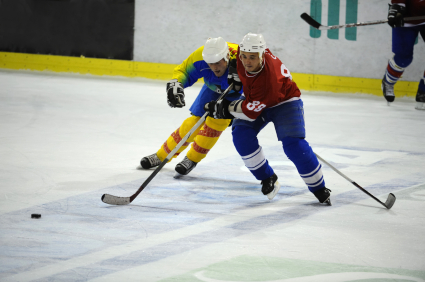No contact with an opposing player's head or neck area will be allowed at any time in high school ice hockey, effective with the 2011-12 school year, one of six rules approved by the National Federation of State High School Associations (NFHS) Ice Hockey Rules Committee at its April 18-19, 2011 meeting in Indianapolis, and subsequently approved by the NFHS Board of Directors. Any contact of that kind could result in a stand-alone minor or major penalty, or even a disqualification.
The ban on head or neck contact (Rule 6-8) was made to heighten awareness of the seriousness of any type of contact to the head, as well as that of any action that might cause a concussion, much like the potential of serious injury caused by body checking from behind.
"Removal of language allowing officials discretion in administering penalties from Rule 6-8 regarding contact to the head places additional emphasis on head or neck contact to an opposing player," said Tom Shafranski, chair of the rules committee and an assistant director of the Wisconsin Interscholastic Athletic Association.
"It is the hope of the committee that this stricter language will further address concussion management, rough play and the overall well-being of a player's health in high school ice hockey."
Other rule changes
The committee also revised Rule 6-29-2, which now allows play to continue after a shot on goal, resulting in a delayed offside.
The committee removed language from the rule and added a note stating, "If the puck enters the defending team's goal during a delayed offside or immediately after the offside, the goal is disallowed."
The revised rule will allow play to continue, allow a defensive player to gain possession of the puck and advance the puck up the ice, and allow the game to continue without a faceoff.
"The present rule is a disadvantage to the defensive team because it provides the attacking team a faceoff," said Dan Schuster, NFHS Education Program Specialist and liaison to the Ice Hockey Rules Committee. "The change will add flow to the game, eliminating unnecessary stoppages in play." 
The addition of Rule 2-3-4 requires teams to remain in their respective bench areas until the referee signals the players to proceed directly to their respective dressing rooms.
The intent of this new rule is to decrease the potential of conflict between the teams at the end of a period.
"The committee felt it unnecessary for teams to cross paths after periods and wanted to minimize the opportunity for unsportsmanlike behavior," Schuster said.
The committee also changed Rule 6-39-1, which will allow all regular-season games to be played under overtime procedures adopted by the respective state high school associations.
Two final changes to the ice hockey rules book are revisions that the NFHS Board of Directors has approved for use in all NFHS rules books.
The first rule extends the clerical duties of officials beyond the end of the game through the completion of any reports required from actions that occurred while the officials had jurisdiction.
The second authorizes state associations to grant exceptions to NFHS playing rules for participants with disabilities, special needs or extenuating circumstances.
"The rules revisions approved by the 2011 NFHS Ice Hockey Rules Committee reflect the current stability of high school ice hockey," Shafranski said. "The NFHS has been at the forefront of national organizations in emphasizing the importance of recognizing and properly managing concussions, as well as educating individuals associated with the game regarding such practices."
Source: National Federation of State High School Associations








